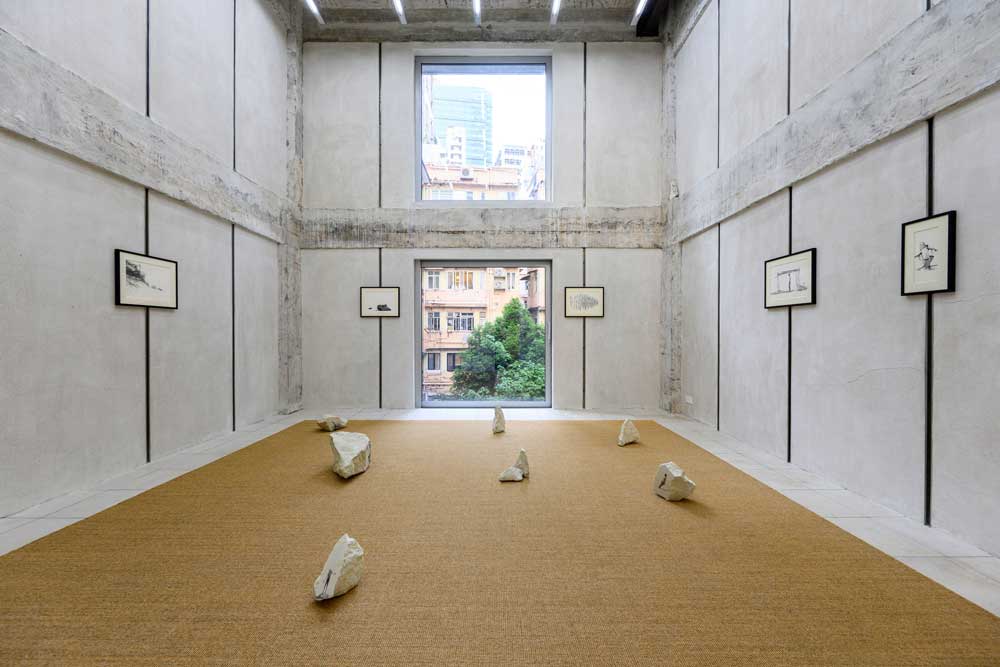展期 Period:
2024.5.17—2024.6.29
艺术家 Artist:
地点 Venue:
马凌画廊 Kiang Malingue(香港适安街)
前言 Introduction:
马凌画廊荣誉呈现「于岛至屿,地消景散」,展出法比安·梅洛近年以纸、岩石及觅得陶片为媒介创作的绘画作品。在过去的八年时间内,梅洛一直致力于描绘法国西岸奥莱龙岛加苏角区域的景观及地貌。
此次展览中的十三幅纸上绘画作品持续探索奥莱龙岛的独特风貌——因全球暖化状况而逐渐被海水淹没的岛屿。梅洛在2016年开始此系列绘画创作,把代表了他本人的标志性形象——一位穿着睡衣、与梦幻及噩梦时刻保持亲近度的男性形象——置于奥莱龙岛的自然环境之中,时而与海岸上的人造结构展开互动。在与这海岛景观对峙五年后,梅洛意识到,他被这风景所吸引,正因为它在逐渐消失;在2016年完成的画作难以代表海岛的现实,因为逐渐上升的海平面已然侵蚀了部分土地。梅洛在此次展览的作品中首次直接描绘了水面及海洋,而画作中的树木、岩石、掩体及防御设施等均已在长眠水下。
梅洛曾于2005年在西安学习中国绘画艺术,这一段影响深远的启蒙经历在很大程度上奠定了其标志性绘画风格——他推崇中国绘画处理无声图景的虚实画法、崇敬山水的创作态度,以及积极调动观者想像力的做法。他在宁淡画作中记录自己多年来在奥莱龙岛进行的身体实践:在树木上登高望远(《侦查树》,2024);拥抱树干,与自然合而为一(《直到最后》,2024) ;跟随树木的韵律,在水中舞蹈(《舞》,2024);躺在二战遗留的掩体之上(《掩体》,2024),或直立站在简陋木屋之中(《框架》,2024)。梅洛在画面中采取的诸多姿态似乎在丈量事物,又像是为已消失的自然或人造物片段提供不在场证据。对于他来说,空灵的画面指引了精神及身体层面的自由,也指引了这样一种欲求:「以不干预的方式与自然合而为一。」
「于岛至屿,地消景散」展览中的其他纸上绘画作品描绘了更为奇幻的图景;以《正午》(2024)为例,这件作品中可见艺术家的侧脸,其中的蜘蛛则指向了义大利塔兰泰拉舞蹈的精神——舞蹈能够帮助人们通过记忆和幻想逃离癫狂和死亡。在白垩石灰岩及陶片上以墨水及酒精创作的十数件绘画作品强调了觅得材料的碎片式形状,这些材料原本用于建筑结构及装饰物件,展示了梅洛对栖息地、考古元素的兴趣,也展示了他对在户外空间直接创作的兴趣。通过呈现具有强烈雕塑形式的绘画作品,通过并置细腻的笔触及貌似有机的型态,梅洛质询了人类文明的消逝过程,揭示了世界各地岛屿、陆地以族群关系彼此相连结的愿景。
Kiang Malingue is pleased to present "From island to island, the landscape that disappears", an exhibition of recent drawings on paper, tuffeau stones and ceramics by Fabien Mérelle. The drawings are part of the ongoing project to portray the landscape and topography of Pointe de Gatseau on Oléron Island (Île d'Oléron) off the west coast of France, which began eight years ago.
A suite of thirteen ink on paper drawings continues to explore the unique landscape on Oléron Island, where the land gradually vanishes due to global warming. Mérelle initiated the long-term series in 2016, immersing his own avatar—a man in his pyjamas, always remaining in proximity to dreams and nightmares alike—into Oléron Island's natural environment, occasionally interacting with man-made structures along the shores. After contemplating the environment for half a decade, Mérelle realized that he was drawn to the landscape because it has disappeared; drawings made in 2016 could no longer represent the reality of the island, where land is gradually eroded away as sea level rises. Making visible the water for the first time, a large number of drawings shown in "From island to island, the landscape that disappears" are effectively documentations of trees, rocks, bunkers and barricades that are now under water.
In his meticulous style that is deeply informed by traditional Chinese art—its way to calmly face "the silence of the image," to be at the service of the landscape, and to actively incorporate the viewer's imagination—Mérelle captures in drawings the solo performances he carried out on Oléron Island over the years: climbing a tree for a better view (Lookout tree, 2024); embracing a tree chunk in an act of solidarity (Until the end, 2024); dancing, following the movement of branches half-drown in water (Dance, 2024); lying on the remains of a Second World War bunker (Bunker, 2024), or standing straight in a hut (Framed, 2024), as if for measurement or producing alibis for these natural or man-made fragments that are no longer visible. For Mérelle, the deliberately sparse landscapes speak directly of spiritual and physical freedom, as well as the desire to "be one with the nature without disturbing it."
Other drawings on paper envisage scenes that are more fantastical in essence, such as Mezzogiorno (2024), which features the artist's silhouette and is partially inspired by origin stories of Italian Tarantella dances—dancing as a way to, through memory and fantasy, escape madness and death. More than a dozen ink-and-alcohol drawings on tuffeau stones and ceramics underscore the fragmentary quality of the found objects that were originally used as construction materials and decorations, demonstrating the artist's interest in exploring habitats and archaeological elements, and in creating art in situ. By presenting drawings that are also sculptural in form, and by juxtaposing punctilious depictions with pseudo-organic shapes, Mérelle reflects on the transitory nature of civilisation while envisioning intercontinental, archipelagic connections between islands and lands.

